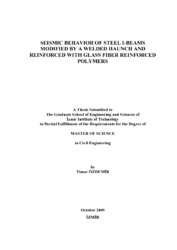Please use this identifier to cite or link to this item:
https://hdl.handle.net/11147/3799| Title: | Seismic Behavior of Steel I-Beams Modified by a Welded Haunch and Reinforced With Glass Fiber Reinforced Polymers | Authors: | Özdemir, Timur | Advisors: | Eğilmez, Oğuz Özgür | Publisher: | Izmir Institute of Technology | Abstract: | Flange and web local buckling in beam plastic hinge regions of welded steel moment frames (SMF) can prevent beam-column connections to achieve adequate plastic rotations under earthquake-induced forces. As the use of fiber reinforced polymers (FRP) have increased in strengthening and repair of steel members in recent years, using FRPs in stabilizing local instabilities have also attracted attention. Generally, high modulus carbon FRP (CFRP) laminates, with elastic modulus similar to that of steel, are preferred in strengthening applications. On the other hand, glass FRP (GFRP) has a much smaller modulus than that of steel, typically one order of magnitude less, which limits its use in strengthening applications. However, this modulus mismatch is an asset when the primary goal is to stabilize inelastic local buckling with the least possible strength increase in the section. In a steel-GFRP hybrid system, while the low modulus of GFRP will not allow a significant strength increase in the beam, the flexural strength of GFRP can provide bracing to the underlying steel, which is flowing plastically. In this research study, the cyclic behavior of steel beams modified by a triangular haunch welded to the beam bottom flange only and reinforced with GFRP laminates at beam flanges have been investigated by finite element analysis (FEA). Cantilever I-sections with flange-web slenderness ratios higher then those stipulated in current seismic design specifications are analyzed under reversed cyclic loading. Both bare beam sections and sections reinforced with GFRP are investigated. The effects of GFRP thickness, width, and length on stabilizing local buckling are investigated. The flexural resistance of the beams at column face, interlaminar shear stresses in GFRP strips, and shear stresses at beam-GFRP binding surface are examined. The results reveal that the plastic rotation capacity of steel beams can be enhanced by the use of GFRP strips. | Description: | Thesis (Master)--Izmir Institute of Technology, Civil Engineering, Izmir, 2009 Includes bibliographical references (leaves: 53-55) Text in English; Abstract: Turkish and Enlish ix,55 leaves |
URI: | http://hdl.handle.net/11147/3799 |
| Appears in Collections: | Master Degree / Yüksek Lisans Tezleri |
Files in This Item:
| File | Description | Size | Format | |
|---|---|---|---|---|
| T000211.pdf | MasterThesis | 4.09 MB | Adobe PDF |  View/Open |
CORE Recommender
Page view(s)
214
checked on Jun 10, 2025
Download(s)
56
checked on Jun 10, 2025
Google ScholarTM
Check
Items in GCRIS Repository are protected by copyright, with all rights reserved, unless otherwise indicated.